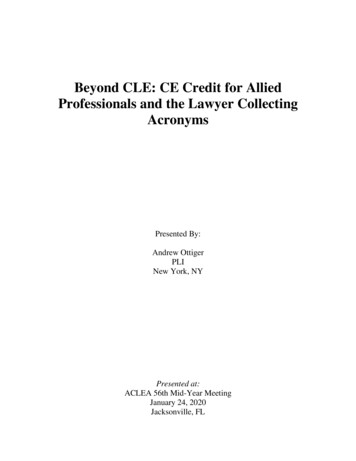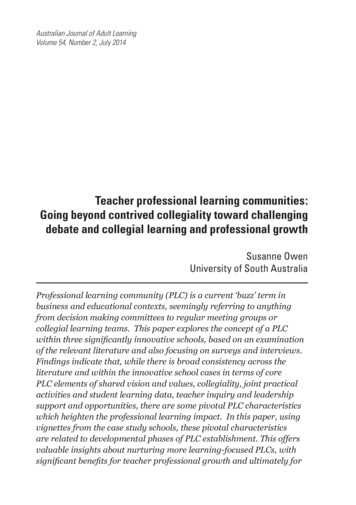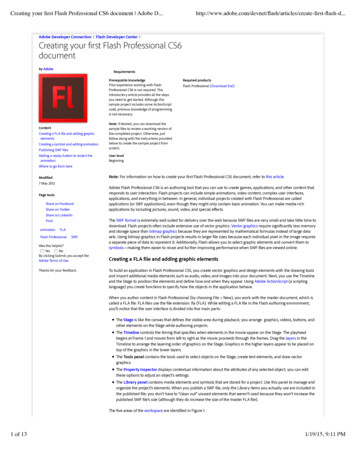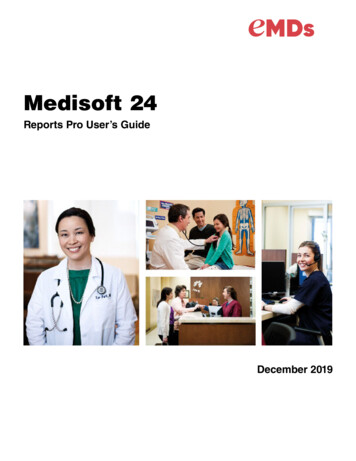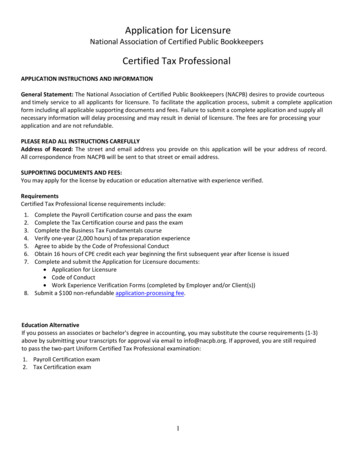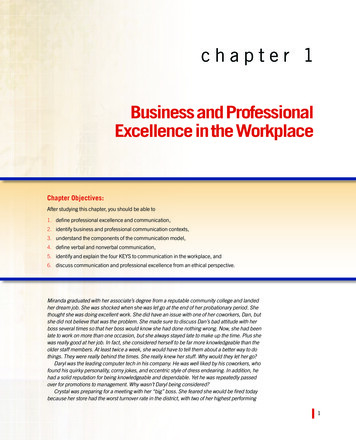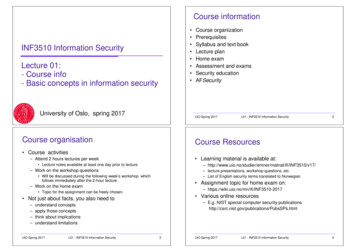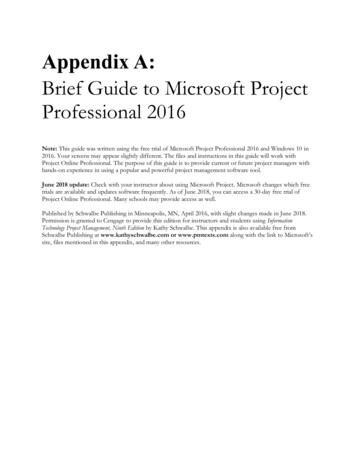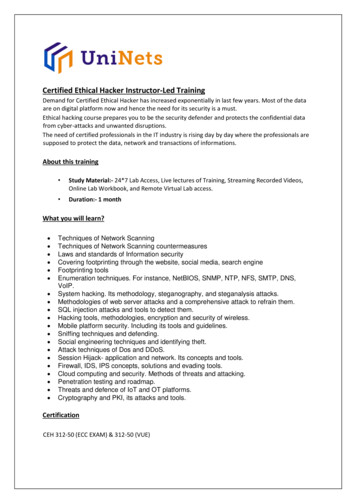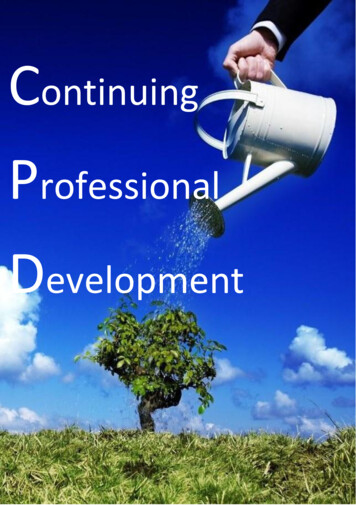
Transcription
Page 1ContinuingProfessionalDevelopment
Page 2Managing your o wn Development“Learning is ongoing, you can learn from every interaction it is one of thetrue joys in life - and it’s free.”Continuing Professional Development (CPD) is theaction we take to maintain, update and grow theknowledge and skills required for our professional role.As the name suggests, it is an ongoing commitment,lasting for as long as we remain within our profession.As L&D professionals, our capability is our product. Ifwe are not knowledgeable in our subjectareas or we do not know how to support andfacilitate learning, then how can we help others in ourorganizations?CPD is an essential investment in our career anddoubly important to us if we are to role model thecommitment to learning and development we expectfrom others. Taking CPD and keeping an appropriaterecord of it is a strong recommendation to themembership of ITOL however it is often arequirement of most other professional bodies.In ITOL we treat our members as mature fellowprofessionals whom we trust. We believe thatRecognizing the need for CPD wouldbe common to us all, however thecontent and amount of developmentwill be unique to each individual. Weare not here to police the professionnor to act as a stern head teacher,therefore we do not ‘require’ but‘recommend’The fact that we are in this profession suggests that weare already enthusiastic learners. CPD requires us to
Page 3focus a part of our learning specifically on areas thatare related to our profession – but L&D is a very widefield, and there are few things we can learn that donot contribute in some way to our abilities to helpother people with their learning.The benefits of developing ourselves are boundlessnot just for us but also for our learners, theorganizations we work in or with, and the L&D teamor function we are a part of. Just to refresh our mind,some of them are:Benefits for you:enhanced reputation and job satisfaction;increased confidence and self-esteem;improved career prospects and employability;improved professional status;development is a transferable skill.Benefits for your learners:better quality training; up-to-date advice andinformation;training that employs new approaches and methods;training that better meets needs;greater confidence in the training provided for yourorganization.Benefits to your L&D function:enhanced reputation;more likely to be seen as credible and reliable and tobecome a trusted partner in the business;more influence with key stakeholders;a more exciting learning environment andopportunities to learn from each other.
Page 4Benefits to the organization:staff who can do the job;more likely to achieve evolving organizational goals;managers can be confident that staff skill levels arecompliant and up-to-date with requirements;improved employee engagement;enhanced external reputation.Undertaking continuing professional development isnot just about setting personal developmentobjectives and fulfilling these, it is also about reflectingon our learning and applying it to our working life. Weshould also record our learning activities andreflections to capture our progression as learners andalso to demonstrate our commitment to CPD to otherparties.The concept of CPD reflects both the Training cycle andthe Learning cycle. It follows the Training cycle in thatwe need to identify our learning needs, find learningto meet these needs, access the learning and thenevaluate how well our learning needs have been metand then start again!CPD also follows the Learning Cycle in that it requiresus to reflect on our experiences, find new ideas andways of doingthings, andexperiment withour new ideas –and then startagain reflecting onour newexperience.
Page 5Key Features of C P D:CPD includes an element of planning andan element of recording and reflecting. Youmay already have a ‘development plan’ atwork or you may want to devise your own.Planning your CPD is important to ensurethat you take a strategic approach to yourprofessional development and includeeverything needed to meet yourprofessional requirements. You might linkyour development plan to a performancereview cycle at work, or it might besomething you do on an annual, or morefrequent, basis.You will need to set some objectives foryour development so that you canmeasure your progress towards, andeventual achievement of, your objectives.You should review your progress towardsobjectives regularly and ensure you stay ‘ontrack’, particularly for learning objectives thatare compliance or qualification related.As well as planning your CPD you should alsorecord and reflect on your CPD and considerhow you will make use of your learning. If youcan get into the habit of recording yourreflections as you go along it will be easierand more useful to you.The way you record your CPD reflections is upto you although ITOL provide some suggested
Page 6formats and templates to our members.There are likely to be learning activities andlearning experiences that you have notplanned but which are relevant to your overalldevelopment and that you want to include inyour CPD record. That is fine it is your recordto use as is most useful to you.You may need to make your CPD recordavailable to other parties occasionally, but itis usually acceptable to provide a reduced orsummary version if you are uncomfortableabout revealing the full document.In our experience different people like differentformats of CPD plans and Records and there is no ‘onesize fits all’. Most seem to opt for a table style ofdocument although other styles are becomingpopular for example mind maps etc. ITOL provide acomplete range of CPD documentation along withother items to support you in the process.
Page 7Choosing Development ActivitiesThere will be a number of practical factors impactingon your choice of development activity, including:costs; availability; time. However beyond these issueswe need to consider a balance of learning across anumber of other competing factors.maintenance V development needs:- What youneed to keep refreshed and up-to-date againstwhat will be new areas of learning for you.specialist subjects V training skills/knowledge:- Ifyou train in a particular subject area you will need tomaintain your technical abilities and knowledge, aswell as developing your skills and knowledge as atrainer.performance requirements V personal aspirations:- Aswell as the learning you have to undertake for your joband professional requirements, you may also havepersonal aspirations or long term plans you want toprepare for.
Page 8Different Learning MethodsEven if you have a preferred way of learning, it isimportant to engage with different approaches. Challengeyourself! Opt for a highly participative learning activity,even though you would normally choose to learn throughresearch or reading. If work-related development needs tobe very logic and reasoning based, you should considerbalancing this by taking some more ‘creative and artistic’development activities.There is a vast amount of established learning contentout there but we also need to be aware of some of thelatest developments that can enhance our careerprospects. New ideas relating to learning are emergingfrom all kinds of fields including neuroscience (how thebrain works), psychology (how people behave) andTechnology. New models of learning communities andongoing developments in virtual learning environmentsare all worth exploring.Sometimes it does us good todo some light-hearteddevelopment that may appearto have little professionalconnection but could just ‘lighta spark’ of a future learningdirection, or at least be a goodstress reliever. Who knowswhat attending a ‘juggling skillsworkshop’ could lead to – you’llnever know ‘til you try!As an L&D practitioner you will be very aware of themany formal types of learning activity available toyou. Before undertaking any of these activities, ask
Page 9yourself ‘what is my objective for doing this, what doI want to learn?’ Having completed the activity, askyourself ‘What did I learn and how will I use it?’FREQUENTLY ASKED QUESTIONS1.What is ITOL’s attitude to CPD?ITOL believes that personal and professional developmentis vitally important! Your ITOL membership and your postnominal letters signify that you are professionallyqualified, experienced and that you actively keep yourknowledge and skills up-to-date. It is important thatyou meet these expectations by making the most ofdevelopment opportunities, continuing your personaland professional growth. We also believe that yourgrowth and development as a person is just asimportant as your development as an L&D professionaland often the two are linked.We recognize that the majority of members also need tobe subject matter experts in their specialist field, so avery broad view is taken toward what constitutes‘professional development’. We also recognize that manymembers have parallel memberships with their specialistprofessional bodies. Many professional bodies take a rigidview of CPD e.g. “you must do 20 hours per calendaryear”, this puts ITOL in a difficult position because if wewere equally rigid over specific amounts of CPD then ourmembers could find themselves spending more time inCPD than actually working!
P a g e 10ITOL’s approach to CPD flows from our corporate values,in particular that we recognize you as a mature fellowprofessional and our starting point is one of trust2.W h a t i s r e c o g n i z e d a s CP D ?Personal and professional development is a normal partof a professional’s working life. It may be achievedthrough training programmes, or through attendance atevents, undertaking new work activities, reading books ormagazine articles or even by chance.In order for personal and professional development tobe useful, it needs to be identified and consolidated.The easiest way to identify and consolidate thisinformation is to keep a personal professionaldevelopment activity record. We encourage you toundertake a process of planning, recording andreviewing personal development activities to help youto develop your professional skills and knowledge. Youcould devise your own system or make use of thematerials provided by ITOL.3 . W h o i s r e sp o n si b l e f o r m y d e v e l o p m e n tneeds?You are. Only you can decide what your goals are andhow best to achieve them. Try and be honest, setrealistic goals and outcomes and adapt your plans asthe need arises. Remember the only person who willsuffer if you cut corners is you.
P a g e 114 . H o w m u c h p e r s o n a l a n d p r o f e s si o n a ld e v e l o p m e n t sh o u l d I a c h i e v e ?This is for you to decide based upon the goals youwant to achieve as set out in your Personal andprofessional development activity planner and can beas little or as much as you feel necessary to meet yourgoals or as personal and professional circumstancesallow.5. What’s in it for me?Keeping a record of personalprofessional development activitydemonstrates a willingness to take control of yourdevelopment. It will show employers that you arecommitted to learning and see this as a long termbenefit. It will assist you when preparing your CV andfor job interviews, acting as an aide memoir to thelearning and development you have undertaken.6.H o w d o I st a r t ?As with most things, the next step forward is to take alook back at what has been achieved. Ask yourself thefollowing:What have my main career achievements been overthe last three years?What have I learnt that has really made a difference?What will I need to do differently in the future?Why do I want to continue to learn?What do I want to achieve in the next three years?Why will this be important for me?
P a g e 127. What is a Development ActivityPlanner?The activity planner is designed to help you think aboutwhat might be desirable for you to do and learn in theyears ahead. It is not prescriptive and you may find thatyou do not complete everything on your list. The planneralso includes a section for reviewing your progress againstyour goals, this provides you with the opportunity toconsolidate what you have learnt so far and to review andimplement new plans. We suggest that you carry outreview sessions at regular intervals to ensure that thelearning carried out is in tune with your goals.8. What is a Record of DevelopmentA c t i v i t i e s?The record of activities is for you to record your ownpersonal and professional development, such as anytraining you undertake, courses or events you attendand any in-house or on the job training you receive.9. What should be recorded in my Recordo f D e v e l o p m e n t A c t i v i t i e s?We would expect to see a range ofdevelopment opportunities recorded,including some or all of the following:formal qualifications, work experience,one day or short courses, reading and personal researchon topics relevant to your work and your career, personallearning and activities undertaken outside of work.
P a g e 1310. Why include personal goals?For most people professional and personal goals arelinked and changes in professional or personalcircumstances can have a major impact on each other. Italso shouldn’t be overlooked that skills learnt at work canbe used socially and visa-versa.1 1 . W h a t a b o u t c a r e e r b r e a k s, r e d u n d a n c yor periods of unemployment?We would encourage you to continue to keepdevelopment records during career breaks as you mayhave more time for activities such as reading books ormagazine articles, doing voluntary work, attending retraining programmes etc. all evidence of your willingnessto learn from new situations and to continue with yourdevelopment. When you are able to return to work youcan prove to prospective employers that you kept yourknowledge up to date.1 2 . H o w i s CP D n o r m a l l y c a l c u l a t e d ?The two most common measures for CPD are ‘units’ or‘hours’. Quite often a ‘unit’ will be based on an hour ofdevelopment so we find it easier to talk in ‘CPD hours’ Thefollowing three narratives are guides on how to calculatedevelopment hours:1. You attend a two-day conference which isrelated to your work. You attended sometwelve hours of workshops and sessions but
P a g e 14you were already familiar with much of thecontent, and so decide to award yourself onlythree development hours.2. You need to learn a specific skill, and to achievethis attend a basic training course for a dayprovided by a local training provider. It is a fullday, and virtually all new knowledge. Youaward yourself a full day of seven developmenthours, the maximum that can be claimed in aday.3. You need to learn some information to supporta report you have been asked to prepare. Todo this you spend a day using the internet andmaking telephone calls. You then spend sometime consolidating the learning by writing thedraft report. In all you calculate that thelearning represents a quarter of the workingday, and award yourself 1.5 developmenthours, the minimum that can be claimed in adayWhen awarding development hours be honest withyourself on what you have actually achieved, this willthen enable you to guarantee that your learningobjectives have been met each year.
P a g e 15Finally, remember that undertaking your CPD is itself adevelopment activity. Writing down your goals andplanning how you will address them will give you a muchgreater chance of achieving them. Recording andreflecting on your development activities willconsolidate and enhance the learning you get fromthem. Your CPD Record is a symbol of your commitmentto your own learning and something you can be veryproud of.
Personal and professional development is a normal part of a professional’s working life. It may be achieved through training programmes, or through attendance at events, undertaking new work activities, reading books or magazine articles or even by chance. In order for personal and professional
